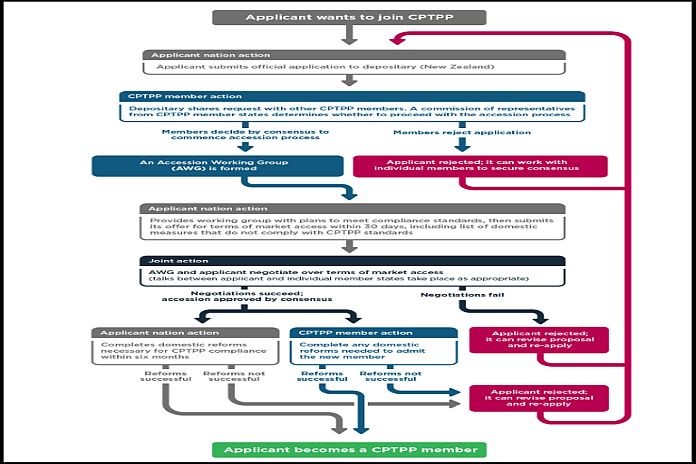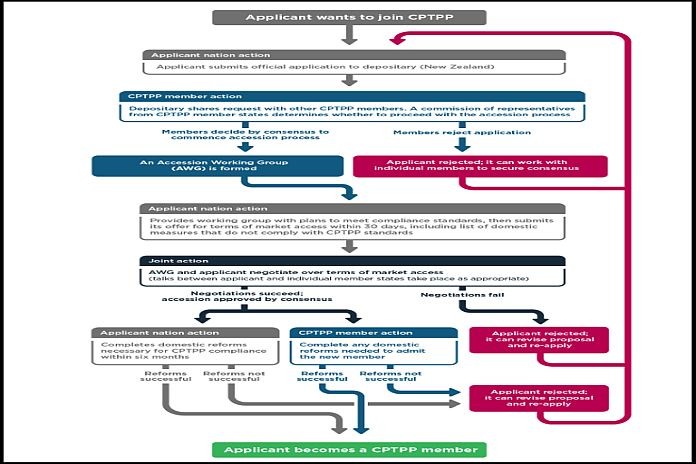Taiwan’s long road to CPTPP membership


By Riley Walters
The Comprehensive and Progressive Agreement for Trans-Pacific Partnership (CPTPP) was back in the news recently, as both China and Taiwan formally submitted applications (see here and here) to join the trade agreement. While they are not the first countries to seek membership in the CPTPP, their applications have certainly caught the attention of trade and geopolitical analysts around the world. Now it will be up to CPTPP members to weigh each applicant’s request. The road to joining CPTPP won’t be easy for either China or Taiwan: the process could take years before any substantial progress is made, as political considerations will weigh heavy on each CPTPP member’s decision-making.
What is the CPTPP?
Besides having a terribly long name, the CPTPP is a trade agreement between Australia, Brunei, Canada, Chile, Japan, Malaysia, Mexico, New Zealand, Peru, Singapore, and Vietnam. The agreement covers a wide range of topics including, but not limited to, trade, investment, government procurement, electronic commerce and data storage, and environment and sanitary measures. The combined economies of these 11 members represent 13 percent of global GDP and 14 percent of global exports in goods and services.
The United States was a party to the trade agreement’s original negotiations, but President Donald Trump officially withdrew the United States shortly after taking office in 2017. The agreement went into force nearly two years after that in December 2018. While the agreement is in force, not all CPTPP members have actually ratified the agreement within their own domestic legal frameworks: Brunei, Chile, and Malaysia, while members of the CPTPP, are not technically a party to the agreement until they ratify it. This is an important point, as only parties to the CPTPP can vote on whether to accept new members.
China and Taiwan both want to join
On September 16, China formally submitted its application to join the CPTPP; six days later, Taiwan also submitted its own application. The timing of the two submissions is more than coincidence. Taiwan officials have been talking about their desire to join the trade agreement for years, but only since late last year has Beijing shown any interest in joining. At the Asia-Pacific Economic Cooperation (APEC) forum, Xi Jinping (習近平) said China would consider joining the CPTPP—which came as a surprise to many given that China had just recently finished negotiations for another large Asian trade agreement, the Regional Comprehensive Economic Partnership (RCEP). The timing of the two countries’ submissions to join the CPTPP is reminiscent of their joining of the World Trade Organization (WTO) around the same time in the early 2000s. Eventually, both joined the WTO as separate members.
A complicated relationship
China’s request to join the CPTPP makes things complicated for CPTPP members. The agreement, while not always explicit, was generally understood to be a counter to China’s growing economic presence in the Asia-Pacific. This concern has grown as countries talk more about diversifying supply chains and building economic resiliency. For most CPTPP members, China is already either their first- or second-largest trading partner. At the same time, it is natural for countries with large existing trade flows to want to solidify the relationship through trade deals—think of the US-Mexico-Canada trade agreement (formally known as the North America Free Trade Agreement).
But while it is sometimes assumed that more trade and better diplomatic relations go hand-in-hand, Beijing’s increasing military presence and belligerence in the region has started to turn opinions against China. In countries like Japan and Canada, negative public sentiment towards China is at an all-time high. For members of the Association of South East Asian Nations (ASEAN), while China is seen as the most influential economic power in the region, nearly three-quarter of members say this is worrying. Nearly two-thirds of ASEAN members have no or little confidence China will do the right thing when it comes to global peace, security, prosperity, and governance.
China’s and Taiwan’s respective political relationships with each CPTPP member make the possibility of joining the CPTPP more complicated. While both countries have existing trade agreements with various CPTPP members—Taiwan has free trade agreements with Singapore and New Zealand, and China has trade agreements with every CPTPP member except Canada and Mexico—this won’t necessarily make their accession processes any easier. CPTPP members have had mixed reactions to both China’s and Taiwan’s submissions: for example, Japan has been the most vocal about welcoming Taiwan to join the CPTPP, while Malaysia has welcomed China’s membership.
The accession process
To join the CPTPP both China and Taiwan first have to clear a few steps. Before even submitting their applications, both countries should have engaged with all 11 CPTPP members regarding their interest in joining. However, now that both have formally submitted their application to join, it will be up to the CPTPP Commission to decide within a “reasonable period of time” whether to accept either country’s application. Given that China submitted its application before Taiwan, it’s fair to assume they may review China’s first. But a “reasonable period of time” is not a deadline and could take some time. As a point of reference, it took roughly four months between the time the United Kingdom submitted its application to join and when the Commission decided to commence accession negotiations.
After accepting a request, the Commission will then set up Accession Working Groups for both China and Taiwan. The Accession Working Group is meant to work with the aspiring economy on their compliance with the existing CPTPP agreement. Eventually, the Commission will decide on whether to accept the aspiring economy. The Peterson Institute for International Economics has produced a good chart mapping the accession process, as shown below:
All decisions made by either the Commission or Accession Working Group are made by consensus agreement among the eight parties to the CPTPP. However, throughout this entire process CPTPP members are intended to “reaffirm the importance of maintaining solidarity among CPTPP Signatories” and “[include] all CPTPP Signatories in the decision making process… Decisions on issues relating to accessions will be made by the Parties taking fully into account the views expressed by those Signatories.” This essentially means that while Brunei, Chile, and Malaysia won’t have an explicit say in whether China or Taiwan can join the CPTPP or not, their opinions are still likely to be taken into consideration.
China’s accession
Both China and Taiwan need to adhere to the agreement already negotiated by CPTPP members. Members like Japan have said they are unwilling to ease rules for China accession—meaning while some CPTPP members may have received exemption from certain parts of the CPTPP when it was first being negotiated, China will not be so lucky. And it is questionable whether China can make the necessary changes to get into the CPTPP now: for example, while the CPTPP agreement recognizes that state-owned-enterprises may play an important role for some of its members, the heavy interventions into China’s markets by both the central and local governments go beyond what is acceptable under CPTPP rules. Beijing will have trouble adhering to more liberal provisions in the CPTPP, such as those related to opening electronic commerce and data storage. There are also concerns about China’s labor and environmental commitments.
Taiwan’s accession
Taiwan’s membership in the CPTPP would be significant. National Development Council Minister Kung Ming-hsin (龔明鑫) said he expects Taiwan’s economy to grow by 2 percent if it joins CPTPP, but that it would lose half a percent if it does not. While Taiwan is a more open economy than China, meaning that not as many changes would need to take place in order for Taiwan to abide by the CPTPP agreement, there are still a few outstanding issues that need to be resolved. For Japan, Taiwan’s biggest supporter for getting into CPTPP, it will be resolving the issue of importing food from Japan’s Fukushima region. (The United States just recently lifted all restrictions on imports from this region in Japan.) Aside from this, Taiwan’s accession would be relatively easier than that of China.
Conclusion
The submissions by China and Taiwan to join the CPTPP could drive a wedge between its members as they debate who should join. But members should not forget the spirit of the agreement laid out in its preamble. CPTPP members are striving to establish a free trade agreement that strengthens their bonds and cooperation. The agreement is meant to build on the rights established at the WTO, while recognizing the cultural differences and diversity between its members. Finally, its members strive to expand the agreement by encouraging other economies to join.
Taiwan continues to be a beacon for democratic values and economic freedom in the region, but at the news of Taiwan’s submission to join the CPTPP, China’s Foreign Ministry came out in strong opposition. If China becomes a party to the CPTPP before Taiwan does, it will surely block Taiwan’s membership. This goes against the spirit of the CPTPP and should preempt China’s membership.
The main point: Neither China’s nor Taiwan’s membership in the CPTPP is guaranteed. The process could take years, as it will be plagued by political considerations and technical negotiations. But given the spirit of the free trade deal, and relative ease by which Taiwan could join, its application should be given priority over that of China.
Riley Walters is a senior non-resident fellow at the Global Taiwan Institute and deputy director of the Japan Chair at Hudson Institute.
Source: Global Taiwan Institute
Source: caribbeannewsglobal.com


